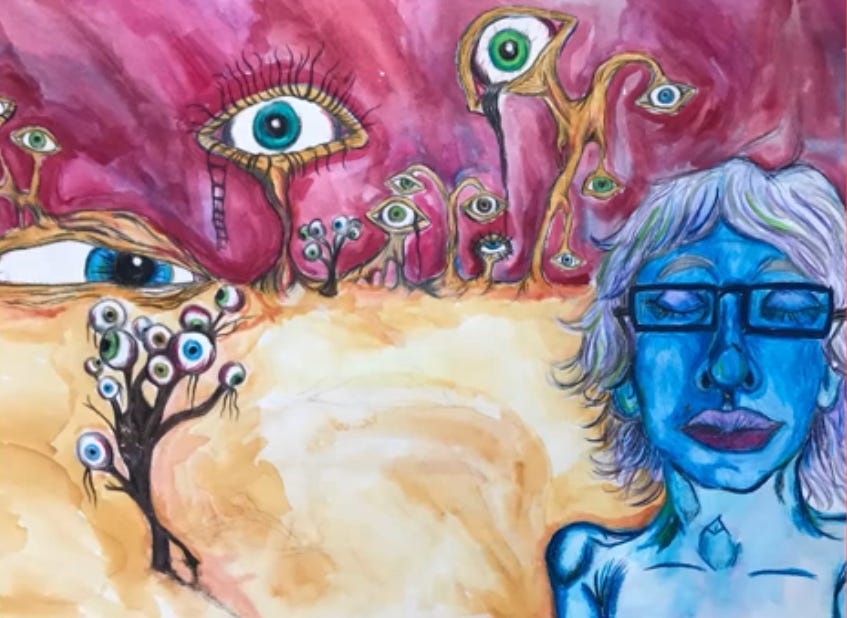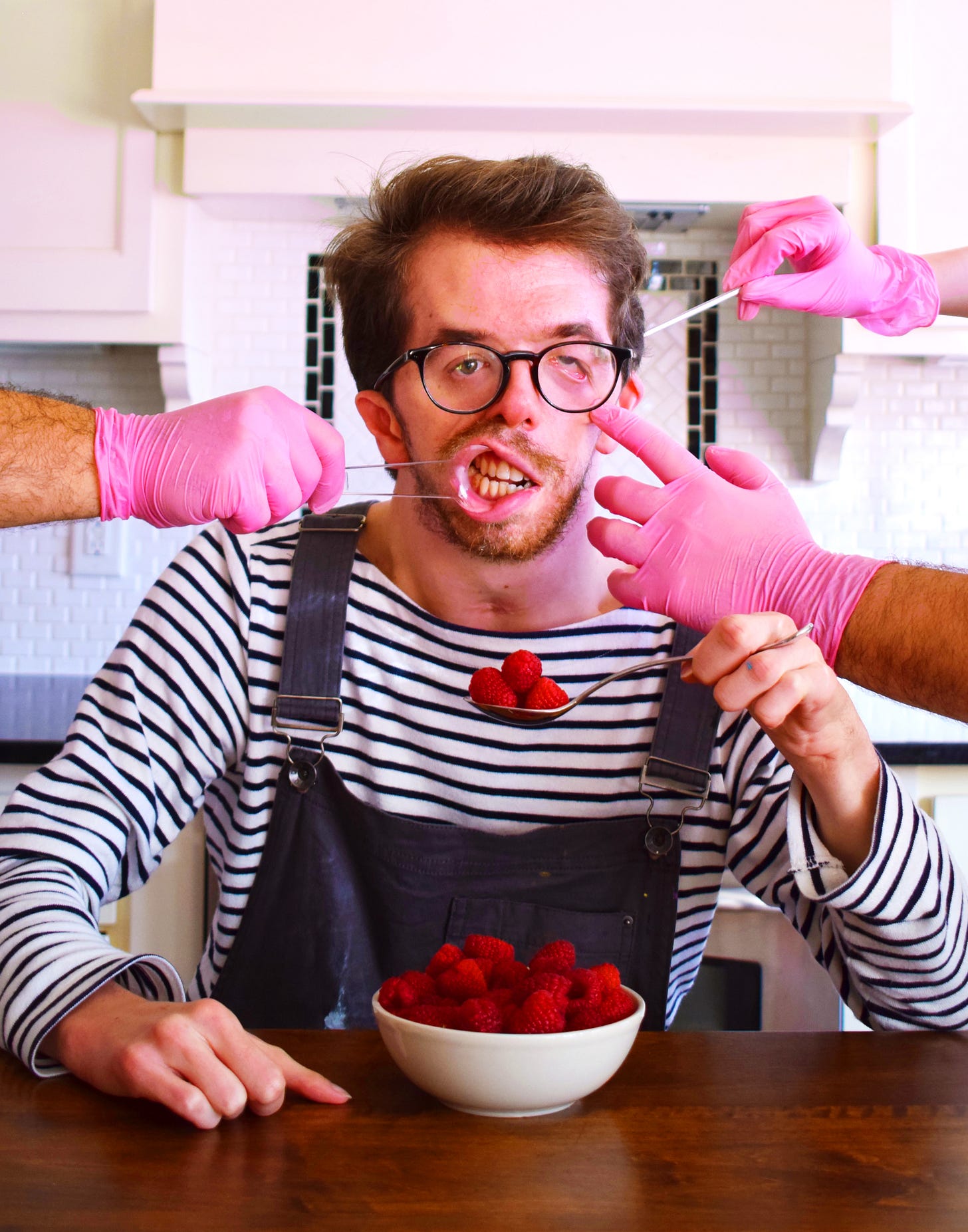I turn 33 tomorrow, and I was about to do this whole thing where I listed 33 things I had learned this past year. In concocting the list, I came to this common thread of what has been sitting on my heart this past year. I couldn’t BuzzFeed this writing. For September, I’ve been trying to use Instagram significantly less. Social media has been a solid frenemy of mine for almost 20 years. I grew up as a teen with MySpace, went to college with Facebook, and continued my adulthood with Instagram. Growing up in a small southern beach town and navigating my medical stuff primed me to find more connections in online spaces.
Self-portrait, 2008, colored pencil and watercolor

As a teen, I found that writing online and sharing my art, whether through a MySpace bulletin or Facebook post, allowed me to express the experiences I was navigating that I felt I couldn’t have voiced as loudly in person then. Strangers coming up to me to ask questions about the way I look and show up is a constant theme in my life as a visibly disabled person. As a teenager, I started reckoning with this and would share these experiences online. Sharing these experiences through writing and art helped me process what was happening; in turn, they would help me express to my peers not to do this. Little did I understand at the time that my being so open online about these things only gave people permission who would see my posts to ask further questions about my body without my consent.
Unfortunately, being in a body that isn’t standard means encountering many experiences you didn’t consent to. It’s a vicious cycle: I am vulnerable about my experiences and share them, increasing the chances of receiving things without my consent, rinse and repeat. In history, we often see a Disabled person either as a recluse, shunned from society, or an advocate forced to be in the limelight due to society’s mistreatment.
There would be waves where I would make art about my experiences and then wouldn’t for a while. I found, though, regardless of how vocal I was about my identity, that the common thread was that I was still being approached by strangers asking me invasive questions. Me making art about it, didn’t stop it. It didn’t make me more comfortable being an encyclopedia for curious strangers. On the flip side, while being met with so much invasiveness, I also gained momentum with my artwork locally. I was making murals and silly little illustrations. I felt a bit all over the place in my mid-twenties. I saw that I was gaining momentum in my city with my art and thought it was time to create something vulnerable. I was thankful for the work I got from clients and felt this need to rebel, to get back to art rooted in my identity. I still felt alone in my experience, especially as I was not only coming to terms with Disability stuff but being Queer as well.
I remember there were times (and sometimes still are times) where people who would follow my art or that I am in the art scene with would try to say hi to me, but due to my deafness and my hearing aid not picking the sounds up, I’d pass them by without any acknowledgment because I couldn’t hear them. I pass so much as a hearing person due to the eugenicist upbringing I had that people don’t know I’m Deaf. Even in one instance, someone told me to go “fuck myself” because they thought I was ignoring them, and a friend had to talk to them to explain that I was Deaf. This is one of the many dangers of being conditioned to mask Disability for the sake of conforming.
“Another Day,” Self-portrait photograph, 2017

So, I pitched an idea to a DIY space in Atlanta to do an autobiographical show and pieces that weren’t drawings or illustrations but videos, photos, and performances, that explicitly talked about my Disabled and Queer experiences. That result was a show called “How Nice,” which featured self-portraits and writings detailing autobiographical aspects of my life, like the ableism I’d witnessed, what it’s been like for me being Deaf, Queer dating as a Disabled person, etc.
It was met with so much love, and I also felt an abundance of burnout from being so vulnerable. Not only was I burnt out, but I also started to have people who saw the show share their deepest secrets with me. I thought at the time that experimenting and being vulnerable would help me not to have to explain myself so much, but I was just naive. It was a big lesson of needing to have boundaries around what I shared and who I shared stuff with.
“When we imagine what being loved would be like, we think of ourselves having tons of fans and a huge platform because we’ve never seen small networks of people just caring for one another, including the people they disliked.” -
Price, “Being Known, and Not At All.”As the years continued, I tried to create more of a better balance between my personal work and client work. When 2020 hit and we went into COVID lockdown, I wound up going a little bit viral on Instagram for a post about being Disabled. The Disability conversation was gaining steam around this time and for a brief moment I felt hope that this would result in a collective change of folks generally being more mindful when it came to Disabled people and things that could disable others. In an earlier piece, I wrote “I used to really obsess about gaining X amount of followers, making ‘content’ to attract more followers etc. Yet, regardless of how many followers I have, my reach is still limited when I speak on things that the algorithms just don’t want me to discuss.
There’s this pattern I am seeing, where I can be Disabled and Queer ‘enough’ but once I start talking about more serious things that deeply impact my global community, is when I get censored. Being Disabled and Queer isn’t palatable. The moments when I am navigating gender dysphoria or chronic pain or feeling frustrated because not enough people are wearing masks can’t be made into ‘content.’ I had these contorted beliefs that I wanted to create representation, that I only wanted to be represented, but I didn’t solely want representation; I ultimately wanted liberation, and I still want liberation.”
“The term parasocial relationship refers to a relationship that a person imagines having with another person whom they do not actually know, such as a celebrity or a fictional character.
This often involves a person feeling as though they have a close, intimate connection with someone whom they have never met due to closely following that person (or character) in media, such as TV shows, videos, podcasts, etc.”
I’ve been seeing so many great conversations about parasocial relationships regarding online spaces. Even with the micro following I have online, I have noticed similar behaviors of strangers online demanding more of me without fully being in reciprocal relationship with me. These conversations I have been witnessing also make me think so much about the expectations people offline have when around other Disabled folks. Making me think about the numerous times that strangers have asked me about my hearing aid, or why I have four fingers, or ask me out of the blue “did you get into an accident?” The expectation that just because they see a Disabled person out in the real world, just running errands, that the Disabled person automatically owes them an explanation regarding why they are Disabled. It feels tough, because I and so many other Disabled folks have to be out in the world. There are times I don’t want to be the on-the-spot educator, on or offline.
It took me a long time to understand that my body will always be perceived; it will always be a magnet to curious people on and offline. In time, I saw how exhausted I was trying to get everyone to understand me. (Hooray for people-pleasing.) I now share what I share to tell people they aren’t alone in what they may be navigating.
I’ve had to get comfortable with the fact that what I share won’t be met with understanding. It won’t be met with reach to everyone. The algorithms won’t do that, regardless of how many followers I have or whatever metrics I use to gain digital visibility. The person who says “hi” to me and I accidentally avoid because I can’t hear them still may not know I am Deaf as many times as I’ve been public about my reliance on a hearing aid. The person who says they’re a fan of my work but continues to misgender me may not have read my writings about me being Non-Binary. As much as I can write and advocate online or offline, I still have to stick my neck out and be uncomfortable, tell people in real-time who I am, and just be grounded in being misunderstood.
The important thing is that I have people in my life who deeply understand me, who want to understand me, and who do everything within their capacity to continue to do so. No amount of strangers on or offline can take that away from me, and I am so grateful.
Growing up, I made art as a means of social survival, to be understood. I see now, though, that the only person I was trying to get to understand me, was myself.




